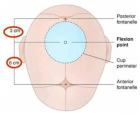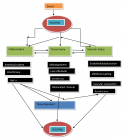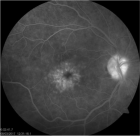Abstract
Case Report
Atopic Conjunctivitis in Children: Influence of Treatment with Topical Cyclosporin 0.05% in the Quality of Life
Carlos Alberto Sánchez Salguero* and Álvaro Isidro Sánchez Chacón
Published: 31 January, 2017 | Volume 1 - Issue 1 | Pages: 001-008
Introduction: Forty-six per cent children have allergic rhinoconjunctivitis (Allergologica 2005).
Working hypothesis: Ocular topical cyclosporine improves the quality of life for these patients.
Material, methods, design: 2-year prospective study (2015-16), 40 patients with topical corticosteroids without improvement, followed 20 and 20 switched to corticosteroids cyclosporine 0.05%. Interview with Quality of Life Questionnaire in Children with rhinoconjunctivitis (PRQLQ) before and at the end of treatment. Mean age of 10.3 years with 60% male-40% female. Treatments were applied from January to March. There were 15 questions divided into two blocks. Children responded using a card with responses rated from zero (not bothered at all) to 6 (quite upset).
Results: Before the 100% reported that, the itching was very bothersome. In the group of 40 children, 80% showed symptoms of epiphora and 60% showed symptoms of ocular inflammation. 100% complained of significant discomfort in rubbing their eyes, 30% did not like to take medications. Headaches affected 20%. 100% stated that they cannot play normally. 80% showed decreased concentration in class.
Continuing with corticosteroids did not show statistically significant changes.
Patients with cyclosporine improved the results by 3 points, with decreased itching, tearing, swelling, pain, eye rubbing, medication and headaches. In the 2nd questionnaire there was limited variation in the results related to fatigue, malaise, and irritability but with substantially improved balance of sleep, insomnia and concentration at school.
Conclusion: Cyclosporine A is a cyclic polypeptide calcineurin inhibitor developed from the fungus Tolypocladium inflatum. The first dilution was 2% but it is currently used at a dilution of 0.05% and recent publications suggest nanosuspensions. Our study showed improvement in parameters related to symptoms, especially itching and lower improvement of psychological aspects, this achieves a better quality of life for children and more willingness to adhere to the treatment.
Read Full Article HTML DOI: 10.29328/journal.haard.1001001 Cite this Article Read Full Article PDF
Keywords:
Allergy; Atopic; Conjunctivitis; Children; Cyclosporine 0.05%; Quality of life
References
- Sociedad Española de Alergología e Inmunología Clínica. Alergologica 2005: Factores epidemiológicos, clínicos y socioeconómicos de las enfermedades alérgicas en España. Madrid: Luzán 5 S.A. de Ediciones. 2006.
- Kari O, Saari KM. Updates in the treatment of occular allergies. J Asthma Allergy. 2010; 3: 149-158. Ref.: https://goo.gl/EAAhex
- Stoppel J. Alergia ocular. Rev Med Clin Condes. 2010; 21: 875-882. Ref.: https://goo.gl/ySZI1M
- Shii D, Nakagawa S, Yoshimi M, Katsuta O, Oda T, et al. Symptoms in Late Phase and Delayed-Type Reactions in Allergic Conjunctivitis Models. Biol Pharm Bull. 2010; 33: 1314-1318. Ref.: https://goo.gl/tYLhfq
- BenEzra D, Peer J, Brodsky M, Cohen E. Cyclosporine eye drops for the treatment of severe vernal keratoconjunctivitis. Am J Opthalmol. 1986; 101: 278-282. Ref.: https://goo.gl/xPFJwP
- Secchi AG, Tognon MS, Leonardi A. Topical use of cyclosporine in the treatment of vernal keratoconjunctivitis. Am J Opthalmol. 1990; 110: 641-645. Ref.: https://goo.gl/EYAQIz
- Kaan G, Ozden O. Therapeutic use of topical cyclosporine. Ann Opthalmol. 1993; 25: 182-186. Ref.: https://goo.gl/EXUx6F
- Bleik JH, Tabbara KF. Topical cyclosporine in vernal keratoconjunctivitis. Opthalmology. 1991; 98: 1679-1684. Ref.: https://goo.gl/EesFfJ
- Gupta V, Sahn PK. Topical cyclosporine A in the management of vernal keratoconjunctivitis. Eye (London). 2001; 15: 39-41. Ref.: https://goo.gl/oBDasp
- Spadavechia L, Fanelli P, Tesse R, Brunetti L, Cardinale F, et al. Efficacy of 1.25% and 1% topical cyclosporine in the treatment of severe vernal keratoconjunctivitis in childhood. Pediatr allergy Inmunol. 2006; 17: 527-532. Ref.: https://goo.gl/GxLsVJ
- Duque B, Restrepo CA. Tratamiento de la conjuntivitis alérgica crónica con ciclosporina tópica. Unidad médica CES 1991-1992. Revista CES Mediana. 1992; 6: 2. Ref.: https://goo.gl/Rpn8im
- Ozcan AA, Ersoz TR, Dulger E. Management of severe allergic conjunctivitis with topical cyclosporine A 0.05% eyedrops. Cornea. 2007; 26: 1035-1038. Ref.: https://goo.gl/0zr4G9
- Kim JH, Woo JS, Dug HS, Don HH, Gon CH. Development of a novel ophthalmic cyclosporine A-loaded nanosuspension using top-down media milling methods. Pharmazie. 2011; 66: 491-495. Ref.: https://goo.gl/f9Of72
- Juniper EF, Howland WC, Roberts NB, Thompson AK, King DR. Measuring quality of live in children with rhinoconjunctivitis. J Allergy Clin Inmunol. 1998; 101: 163-170. Ref.: https://goo.gl/4bAHDe
- Tesse R, Spadavecchia L, Fanelli P, Rizzo G, Procoli U, et al. Treatment of several vernal keratoconjunctivitis with 1% topical cyclosporine in an Italian cohort of 197 children. Pediatr Allergy Immunol. 2010; 21: 330-335. Ref.: https://goo.gl/GyNs3P
- Akova YA, Rodriguez A, Foster CS. A randomised trial of topical cyclosporine 0.05% in topical steroid-resistant atopic keratoconjunctivitis. Ocular Immun Inflamm. 1994; 2: 125-144.
- Pucci N, Caputo R, Mori F, De Libero C, Di Grande L, et al. Long-tern safety and efficacy of topical cyclosporine in 156 children with vernal keratoconcjuntivitis. Int J Immunopathol Pharmacol. 2010; 23: 865-871. Ref.: https://goo.gl/Hj1XzT
- Spadavecchia L, Fanelli P, Tesse R, Rizzo G, Procoli U, et al. Prognosis and treatment of vernal keratoconjunctivitis in pediatric age: pilot study on 197 patients. Minerva Pediatr. 2010; 62: 239-244. Ref.: https://goo.gl/scrQdR
- Keklikci U, Sevda Soker I, Yildirim Sakalar B, Kaan Unlu, Selver Ozekinci, et al. Efficacy of topical cyclosporine A 0.05% in conjunctival impression cytology specimens and clinical findings os fevere vernal keratoconjunctivitis in children. Jpn J Ophthalmolol. 2008; 52: 357-362. Ref.: https://goo.gl/9LReSj
- Hingorani M, Moodaley L, Virginia Calder L, Roger Buckley J, Lightman S. A randomised, placebo-controlled trial of topical cyclosporine A in steroid-dependent atopic keratoconcjuntivitis. Ophthalmology. 1998; 105: 1715-1720. Ref.: https://goo.gl/ortAs4
- Tesse R, Fanelli P, Rizzo G, Spadavecchia L, Procoli U, et al. Treatment of severe vernal keratoconjunctivitis with 1% topical cyclosporine in an Italian cohort of 197 children. Pediatr Allergy Immunol. 2010; 21: 330-335. Ref.: https://goo.gl/3CNyCk
- Daniell M, Constantinuo M, Vu H T, Tayleo HR. Randomised controlled trial of topical ciclosporin A in steroid dependent allergic conjunctivitis. Br J Ophtalmol. 2006; 90: 461-464. Ref.: https://goo.gl/05P6ts
Similar Articles
-
Atopic Conjunctivitis in Children: Influence of Treatment with Topical Cyclosporin 0.05% in the Quality of LifeCarlos Alberto Sánchez Salguero*,Álvaro Isidro Sánchez Chacón. Atopic Conjunctivitis in Children: Influence of Treatment with Topical Cyclosporin 0.05% in the Quality of Life . . 2017 doi: 10.29328/journal.haard.1001001; 1: 001-008
-
Features of Interferon and Cytokine Status in Atopic DermatitisOspelnikova TP*,Gevorkyan OV, Mironova TV,Andreeva SA,Kolodyazhnaya LV,Ershov FI. Features of Interferon and Cytokine Status in Atopic Dermatitis. . 2017 doi: 10.29328/journal.haard.1001002; 1: 009-014
-
Prevalence of reported drug allergy and its impact on Beta lactam use with financial and health implicationsJoanna Lukawska*,Abirami Murugesh-Warre#,Ranu Malhin#,Yogini Jani,Christopher Corrigan,David Walker,Harsha Kariyawasam. Prevalence of reported drug allergy and its impact on Beta lactam use with financial and health implications. . 2017 doi: 10.29328/journal.haard.1001004; 1: 028-035
-
The use of Allergoids and Adjuvants in Allergen ImmunotherapyCelso Eduardo Olivier*. The use of Allergoids and Adjuvants in Allergen Immunotherapy. . 2017 doi: 10.29328/journal.haard.1001006; 1: 040-060
-
Chemo-cytokines network is main target for control of Allergic asthmaSeyyed Shamsadin Athari*,Seyyede Masoume Athari. Chemo-cytokines network is main target for control of Allergic asthma. . 2018 doi: 10.29328/journal.aaai.1001009; 2: 001-002
-
Role of Serum Magnesium levels in Asthmatic with childrenSomashekar AR*,Ramakrishnan KG,Seyyed Vanitha Gowda. Role of Serum Magnesium levels in Asthmatic with children. . 2018 doi: 10.29328/journal.aaai.1001010; 2: 003-005
-
Diagnosis of Asthma in Childhood AgeIbrahim A Ali*,Elia Adil Nabih,Ahmed MS Eltohami. Diagnosis of Asthma in Childhood Age . . 2018 doi: 10.29328/journal.aaai.1001012; 2: 008-012
-
HIV-1 Immune evasion: The main obstacle toward a successful vaccineAmitis Ramezani*,Mona Sadat Larijani,Seyed Mehdi Sadat. HIV-1 Immune evasion: The main obstacle toward a successful vaccine . . 2018 doi: 10.29328/journal.aaai.1001013; 2: 013-015
-
Allergic Asthma and Sick building syndromeSeyyed Shamsadin Athari*. Allergic Asthma and Sick building syndrome . . 2019 doi: 10.29328/journal.aaai.1001015; 3: 001-002
-
Immune system and quality of life following aerobic exercise versus resistance exercise training among Alzheimer’sFadwah M Al-Sharif*. Immune system and quality of life following aerobic exercise versus resistance exercise training among Alzheimer’s. . 2020 doi: 10.29328/journal.aaai.1001018; 4: 003-008
Recently Viewed
-
A Update on Brachytherapy for Cervical Cancer: A ReviewArjun Moorthy,Ayan Issac,Ngoc-Anh Le,Kavin Mutyala*,Bhuvi Mamtani,Shyamal Patel,Lyndsay Willmott. A Update on Brachytherapy for Cervical Cancer: A Review. Clin J Obstet Gynecol. 2025: doi: 10.29328/journal.cjog.1001195; 8: 085-091
-
Superior Gluteal Artery Pseudoaneurysm following a Periacetabular OsteotomyTess Szekelyi, Xavier Lannes, Mouas Jammal, Salah Dine Qanadli, Michael Wettstein*. Superior Gluteal Artery Pseudoaneurysm following a Periacetabular Osteotomy. Arch Clin Exp Orthop. 2024: doi: 10.29328/journal.aceo.1001018; 8: 001-004
-
Breast Imaging Services Utilization Trends Across Private and Government-Insured Patients in a National Radiology PracticeAndrew K Hillman*,Phil Ramis,Patrick Nielsen,Sophia N Swanston,Dana Bonaminio,Eric M Rohren. Breast Imaging Services Utilization Trends Across Private and Government-Insured Patients in a National Radiology Practice. J Clin Med Exp Images. 2025: doi: 10.29328/journal.jcmei.1001037; 9: 020-027
-
Effect of Obesity on the Patients Undergoing to General Anesthesia: A Prospective StudyAhmed Ali Ebshena*,Zubaeda M Alsayeh. Effect of Obesity on the Patients Undergoing to General Anesthesia: A Prospective Study. Int J Clin Anesth Res. 2025: doi: 10.29328/journal.ijcar.1001032; 9: 030-034
-
Transnasal Humidified Rapid-Insufflation Ventilatory Exchange (THRIVE) in High-Risk Endoscopic Procedures: A Non-Intubation ApproachNaba Madoo*,Vaibhavi Baxi. Transnasal Humidified Rapid-Insufflation Ventilatory Exchange (THRIVE) in High-Risk Endoscopic Procedures: A Non-Intubation Approach. Int J Clin Anesth Res. 2025: doi: 10.29328/journal.ijcar.1001033; 9: 035-036
Most Viewed
-
Feasibility study of magnetic sensing for detecting single-neuron action potentialsDenis Tonini,Kai Wu,Renata Saha,Jian-Ping Wang*. Feasibility study of magnetic sensing for detecting single-neuron action potentials. Ann Biomed Sci Eng. 2022 doi: 10.29328/journal.abse.1001018; 6: 019-029
-
Evaluation of In vitro and Ex vivo Models for Studying the Effectiveness of Vaginal Drug Systems in Controlling Microbe Infections: A Systematic ReviewMohammad Hossein Karami*, Majid Abdouss*, Mandana Karami. Evaluation of In vitro and Ex vivo Models for Studying the Effectiveness of Vaginal Drug Systems in Controlling Microbe Infections: A Systematic Review. Clin J Obstet Gynecol. 2023 doi: 10.29328/journal.cjog.1001151; 6: 201-215
-
Causal Link between Human Blood Metabolites and Asthma: An Investigation Using Mendelian RandomizationYong-Qing Zhu, Xiao-Yan Meng, Jing-Hua Yang*. Causal Link between Human Blood Metabolites and Asthma: An Investigation Using Mendelian Randomization. Arch Asthma Allergy Immunol. 2023 doi: 10.29328/journal.aaai.1001032; 7: 012-022
-
An algorithm to safely manage oral food challenge in an office-based setting for children with multiple food allergiesNathalie Cottel,Aïcha Dieme,Véronique Orcel,Yannick Chantran,Mélisande Bourgoin-Heck,Jocelyne Just. An algorithm to safely manage oral food challenge in an office-based setting for children with multiple food allergies. Arch Asthma Allergy Immunol. 2021 doi: 10.29328/journal.aaai.1001027; 5: 030-037
-
Impact of Latex Sensitization on Asthma and Rhinitis Progression: A Study at Abidjan-Cocody University Hospital - Côte d’Ivoire (Progression of Asthma and Rhinitis related to Latex Sensitization)Dasse Sery Romuald*, KL Siransy, N Koffi, RO Yeboah, EK Nguessan, HA Adou, VP Goran-Kouacou, AU Assi, JY Seri, S Moussa, D Oura, CL Memel, H Koya, E Atoukoula. Impact of Latex Sensitization on Asthma and Rhinitis Progression: A Study at Abidjan-Cocody University Hospital - Côte d’Ivoire (Progression of Asthma and Rhinitis related to Latex Sensitization). Arch Asthma Allergy Immunol. 2024 doi: 10.29328/journal.aaai.1001035; 8: 007-012

If you are already a member of our network and need to keep track of any developments regarding a question you have already submitted, click "take me to my Query."


















































































































































